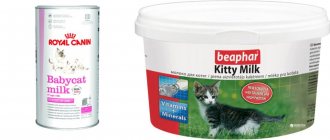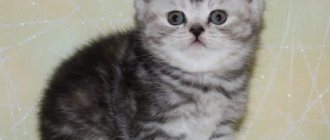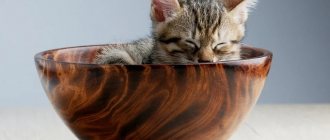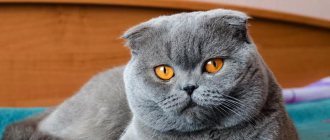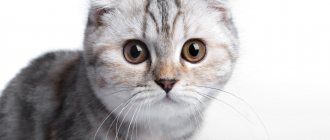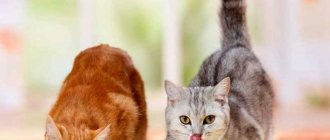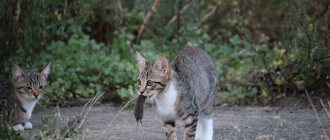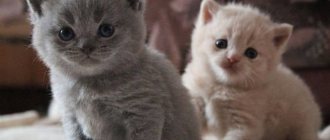The appearance of a Scottish kitten in a family is a joy for everyone, but also a great responsibility. It is necessary not only to equip a place for rest, to purchase everything necessary to keep a pet, but also to create a diet and decide what to feed the Scottish kitten. Regardless of the type of Scottish breed: Scottish Fold, Highland Fold - fold-eared kitten or Scottish Straight, Highland Straight - straight-eared kitten, from the first days babies need a balanced diet.
It is advisable to purchase Scots at 3 months of age, when kittens are weaned from breastfeeding. The owner is faced with the difficult task of how to create the correct nutritional system for the pet as it develops. The health and life expectancy of a Scottish cat depends on the quality, quantity and variety of food.
Features of the Scottish Fold breed
Charming Scottish Fold cats with an unusual appearance have another name - Scottish Fold. A peculiarity of the breed and a distinctive feature of these animals are small ears, the tips of which are curved down and forward. This trait is the result of a gene mutation.
Folds are animals that have a strong build and are medium or large in size. Their fur is soft, short, elastic, slightly plush to the touch and very thick. The colors can be any: plain (chocolate, cream, blue, black, etc.), with a pattern (brindle, marble, spotted), combination with white. Color point color is also allowed.
The homeland of such cats is Great Britain. A fold-eared cat was born on a Scottish farm and was given the name Susie. Later she gave birth to several more kittens with such ears, after which breeders began developing the breed.
INTERESTING! Experts have found that the lop ear gene is semi-fatal. It weakens cartilage and therefore can lead to the development of pathologies of the musculoskeletal system. Because of this discovery, the breed was banned in the UK, and American breeders continued to work on it.
They conducted a lot of research and came to the following conclusion. When Scottish Folds were mated with straight-eared cats (British or American Shorthair), the result was offspring devoid of the double defective gene.
Some kittens had ears characteristic of the breed, while others had standard ears. Since 2004, animals with straight ears have been called Scottish Straights. It is with such representatives that Scottish Fold cats are allowed to be bred.
Choosing dishes and arranging a feeding area
A bowl for a Scottish Fold kitten should be spacious and stable. There must be at least two of them: one for food, the other for drinking water. However, if your pet eats both dry food and canned food or natural food, it is better to have its own plate for each type of food.
Cat bowls can be different:
- Ceramic or earthenware. These bowls are very heavy, so they stay in one place and don’t roll all over the floor. They wash well and do not add any foreign odors to water or food. Such bowls are most preferable for Scottish Fold babies.
- Metal. Such plates can be installed on a special stand. Some bowls have a rubber band around the edge to hold the bowl in place.
- Plastic. These bowls are lightweight, quite stable, and come in a variety of shapes. They can be single, double, with an additional wide stand in the form of a tray, etc.
The kitten's bowl should be quite wide, but not deep. A plate with a volume of 0.1 to 0.4 liters is suitable for food. It is better to choose larger containers for drinking water: from 1 to 2-3 liters.
An alternative to a regular bowl can be an automatic feeder. This device independently dispenses food to your pet up to 6 times a day, depending on the set mode. Instead of a water dish, you can provide your lop-eared kitten with a special fountain in which the liquid constantly circulates and remains fresh.
When choosing a place and dishes, you need to take into account the behavioral characteristics of cats. It is better to install plates for your pet in a stationary place so that your pet gets used to them. Bowls of food and water should be placed next to each other. The best place for cat dishes is a dark corner in the kitchen or dining room.
You can place a special mat or a wide tray under them. Once every 1-2 days, wash the bowls well with hot water, but it is better not to use detergents. Cat dishes should be washed separately from human dishes, as pets can be carriers of helminths.
How to choose good food
When entering a pet store, the buyer is faced with shelves with a variety of food from various manufacturers. They all have attractive packaging, but differ in price. An ignorant person will easily get confused in the choice. Therefore, to begin with, it is better to decide on the class of food. Economy or middle class products are not suitable for Scottish folds and Scottish straights. From them, cats will develop diseases of the digestive or urinary system. Therefore, it is better to take holistic or premium food. Typically, breeders make recommendations for a specific brand of food.
But still, buyers often note that many manufacturers' product quality decreases over time. Therefore, it is better to carefully study the composition. A high-quality food will have meat in the first place. If instead of “meat” it says corn or meat flour or rice, then it is better not to buy such a product. After this, you need to look at the amount of vitamins and minerals in a particular product. This parameter should be controlled depending on the characteristics of the animal and the presence of diseases.
What to feed Scottish Fold kittens
Experienced cat owners and breeders know what to feed a Scottish Fold kitten.
They advise choosing one of three types of nutrition:
- Natural diet. This type is considered traditional. It has a big advantage - the animal receives natural and tasty products. But this type of feeding also has a disadvantage - it is very difficult to balance correctly. Natural food suitable for pets of all ages.
- Ready-made feed. This product is completely balanced and looks like hard small crackers. Dry food varies in composition and quality; premium, super premium and holistic brands are suitable for Scots. This type of food is suitable as the main diet for both small kittens and older and older animals.
- Mixed diet. With this feeding method, the cat receives both dry food and natural food.
Important! breeders recommend avoiding such mixing of products, as this leads to an imbalance of nutrients and can cause vitamin deficiency and developmental disorders in the Scottish Fold.
Rules for feeding natural products
The basis of a natural diet is meat (up to 50% of the total daily value). Suitable for Scottish Fold kittens: veal, turkey, rabbit, chicken. Also, once or twice a week the baby is given fish (pink salmon, salmon, chum salmon and other marine species). Meat or fish are pre-frozen, and before feeding they are scalded with boiling water or lightly boiled.
INTERESTING! From time to time, meat can be replaced with offal. For the Scots, kidneys, liver, and hearts are more preferable.
Scottish Fold kittens must be given cottage cheese, preferably calcined, throughout the entire growth period. You can also offer your baby kefir, fermented baked milk, and low-fat cheese. It is not recommended to give milk to adults and small Scots, as it can cause diarrhea.
The menu must include eggs: quail or chicken. They can be fed to cats either raw or boiled. Some pets enjoy scrambled eggs, but they should be prepared with a minimum amount of milk and no butter. The kitten gets carbohydrates from cereals. The most preferred: buckwheat, brown rice, wheat. They are added to the Scots diet in the amount of 20-25% of the daily value. To ensure that your pet eats them well, you can make a mixture of minced meat or finely chopped meat and cereal.
Vegetables and fruits are also sources of carbohydrates and vitamins. They are fed to cats raw or boiled. You can puree them, grate them on a fine grater, or simply cut them into small pieces.
Among vegetables, the pet is offered carrots, green beans, zucchini, pumpkin, and cauliflower. From fruits, you can give the Scot apples, pears, some plums, peaches.
REFERENCE! If your pet refuses to eat cereals, but enjoys eating vegetables and fruits, you can only use them as sources of carbohydrates.
Ready-made dry food as a kitten's main diet
Dry diets are ready-made balanced foods intended for the daily nutrition of cats.
Such products are divided into four classes:
- Economy The cheapest food. The composition is based on cereals (wheat, corn, etc.). There is a very small percentage of animal protein in such diets, and it is obtained from various waste products from meat processing plants. Economy class feeds include Whiskas, Kitiket, Darling and other products, the cost of which does not exceed 60-80 rubles. per kilogram. Breeders recommend avoiding such foods.
- Premium To prepare such diets, both meat and offal are used, but plant ingredients still make up the majority. The composition includes vitamin and mineral supplements. Such diets can be used as the main menu, but only if the animal feels great and has no health problems. Premium foods include: Happy Cat, Sheba, Brit Premium, Cat Chow, etc.
- Super premium. Such products are made from high quality raw materials. They contain a large amount of animal proteins. Carbohydrates are represented by vegetables and cereals with high digestibility. Super premium food is enriched with minerals and vitamins and contains fruits, berries and other healthy additives. The most popular brands: Fitmin, Brit Care, Blitz, Savarra, etc.
- Holistic. These foods are made from fresh and dried high quality meat. Manufacturers also use sea fish fillets as a source of proteins. The holistic product does not contain cheap sources of plant protein. Potatoes, vegetables, rice, peas, lentils, carrots, apples, etc. act as carbohydrates and fiber. Many holistic products include probiotics. The most popular foods are: Acana, Orijen, Farmina, Grandorf, Applaws, etc.
The best wet food for Scottish cats
Purina Pro Plan Nutrisavour Housecat
Purina Pro Plan Nutrisavour Housecat
This wet food will be the best option for Scottish Folds and Scottish Straights, since it is intended for cats that live indoors. "Purina Pro Plan Nutrisavour Housecat" contains a large amount of protein, thanks to which the pet will maintain normal body weight. The fiber content is also increased here, thanks to this hairballs will not accumulate in the stomach. To improve the animal’s digestion, the manufacturer included prebiotics in the product; this will also reduce the unpleasant odor from the litter box.
"Purina Pro Plan Nutrisavour Housecat" is available in a pouch package. Once opened, the package can be stored in the refrigerator for 24 hours.
Monge Monoprotein
Monge Monoprotein
This product is canned meat flakes. Monge Monoprotein is a mono-protein food because it contains only one source of animal protein. Thanks to this, your pet cannot develop an allergy to such food.
It should not be ignored that Monge Monoprotein is rich in nutrients and vitamins, and also contains taurine. But this product does not contain dyes, flavors, GMOs or other harmful additives. Thanks to this, it becomes possible not only to improve the health of the little friend, but also to extend his life. Since chicken meat is easily digestible, the cat will not have digestive problems.
One can contains 80 grams of food. It is recommended to give about 2-2.5 cans per day. But you should take into account the lifestyle, weight and age of the animal.
Hill's Prescription Diet
Hill's Prescription Diet
If an animal has a disease of its renal system, such food will help speed up the recovery process and prolong the life of the animal. A distinctive feature of Hill's Prescription Diet is the reduced amount of sodium and phosphorus, which will reduce the load on the renal system. And to improve blood flow in the kidneys, the manufacturer added Omega-3 fatty acids. A large amount of antioxidants will help neutralize the effects of free radicals. These components will also be useful in concentrating attention and increasing activity.
Hill's Prescription Diet is available in an 85 gram pouch. The manufacturer recommends introducing this food gradually.
Approximate natural menu by age
The number of feedings and serving size directly depend on the baby’s age. Small kittens under 2-3 months of age eat more often. By six months, Scots are transferred to two meals a day. Let's look at a sample menu by age.
Up to a month
From birth to a month, the babies are fed by the mother with her milk. Once small Scottish Folds are 3 weeks old, they can begin to be offered their first complementary foods. To do this, use raw scraped or very finely chopped meat.
REFERENCE! At 3-4 weeks, kittens just begin to try “adult” food. They can be given rabbit, veal, turkey or chicken. You can also start complementary feeding not with meat, but with fermented milk products (cottage cheese, low-fat fermented baked milk, yogurt).
1 month
From 1 to 2 months, a Scottish Fold kitten eats about 120 grams of food per day, including mother’s milk. Babies are offered food up to 7 times a day.
Kittens happily eat shredded raw meat. Porridge and vegetables are contraindicated for children at this age.
2 months
At 2 months, kittens begin to separate from their mother. These babies are fed up to 6 times a day, with the daily food intake being about 180 grams. You can add some grated vegetables and bran to pieces of meat (this product has a beneficial effect on digestion).
3 months
At 3 months, Scots begin to go to new homes and are separated from their mother. The basis of the diet of such children is still meat, but the menu already includes fermented milk products (cottage cheese, stale kefir, fermented baked milk, etc.), vegetables, and chopped fruits.
A kitten aged 3-4 months eats up to 240 grams of food per day. You can start introducing the kitten to cereals. The meat is given to the pet raw. It is cut into fairly large pieces.
From 4 to 6 months
The volume of food consumed can be increased to 300-320 grams, but this only applies to very large Scottish Folds. For a medium-sized kitten, 280-300 grams of food is enough. At this age, the pet begins to be introduced to sea fish. It is fed to the baby scalded or boiled 1-2 times a week.
Also, at 4-6 months, a Scot will begin to be given sprouted greens. At this age, the kitten is already actively eating fruits and vegetables, and happily eats meat cut into large pieces.
REFERENCE! The number of feedings at 4-6 months is reduced to 3.
From 6 months to 1 year
From 6 months, the kitten begins to be switched to a 2-meal diet. The average daily intake is 180-230 grams. This figure can be calculated using the formula: 3-5% of the animal’s body weight.
At the age of 6 months to 1 year, the lop-eared pet eats all foods: raw meat, fish, cereals, cottage cheese, fermented baked milk, vegetables, fruits, herbs. You should not offer bones to the animal, as their sharp fragments can pierce the stomach.
Nutrition for an adult cat
A cat with an average activity level needs to get a basic set of calories from food. If she is very active, she will need 20-40% more food than indicated on the food package. And vice versa: a weakly active pet may eat less than the prescribed portion, and there is nothing wrong with that.
Adult animals need taurine: it helps the heart, visual and reproductive systems function normally. This substance is found only in animal foods, so it is important for your pet to eat meat products.
To stay cool in hot weather or, conversely, to stay warm in frosty weather, a cat may require additional energy and, therefore, a different diet. You should contact your veterinarian: he will tell you how, how much and what to feed your pet.
Adjustments in nutrition are important both for sick animals and for those who have undergone surgery. Here you also cannot do without consulting a veterinarian. If the owner does not have the opportunity to feed the pet at certain hours, you can put a daily portion of food in a bowl. She herself will distribute this volume throughout the day.
Be sure to read:
How to care for a British kitten: feeding, education, mating features, when to vaccinate
Drinking regime or amount of water for a kitten
Drinking enough drinking water is vital for all cats, including Scottish Fold kittens. A lack of fluid intake can lead to the development of diseases such as urolithiasis.
An adult Scottish Fold should drink up to 250 ml of clean drinking water per day. Pets that eat exclusively dry food drink more than animals whose main diet consists of natural products.
A fold-eared cat may refuse water for various reasons:
- The pet does not like the container in which the water is poured.
- The cat drinks not only from the bowl, but also in other places in the house.
- The pet does not like the taste of water.
As a container, it is better to use glass or ceramic wide bowls with a volume of at least 400-500 ml. Dishes must be washed daily, as the water may turn sour and acquire an unpleasant taste or smell. You can also offer the Scotsman liquid passed through a regular water filter.
Features of nutrition after castration or sterilization
After sterilization/castration, Scottish cats are prone to obesity - this is a restructuring of the animal's hormonal levels.
After sterilization/castration, Scottish cats and female cats are prone to obesity
During this period, you need to reduce the amount of food, but increase the number of feedings:
- Eliminate fish from your cat's diet: due to their high content of magnesium and phosphorus, they cause urolithiasis.
- Include vitamins, fiber and other mineralized supplements in your menu.
- Once a week you can give offal: they contain a lot of protein.
- Feed more porridges, to which you occasionally add meat to add aroma and taste.
- Feed the animal meat without fat: turkey, rabbit, veal, chicken breasts, cut into small pieces.
- Give broth made from lean meat, pureed raw vegetables.
Advice! Grow greens and feed them to your pet.
When choosing factory food, you need to pay attention to o or “For castrated cats.”
Products prohibited for Scottish Fold kittens
Experienced breeders tell us what not to feed a Scottish Fold kitten:
- Products containing alcohol. This substance has a negative effect on the cat's liver. Alcohol causes severe poisoning in Scots, which can result in coma and death.
- Products containing cocoa or chocolate. They contain the substance theobromine. It is poisonous for cats, as it causes an increase in heart rate, which causes the development of arrhythmia. If a lop-eared kitten eats at least one piece of chocolate, its thirst increases and diarrhea may begin. A large amount of theobromine leads to the development of a heart attack.
- Caffeinated drinks (tea or coffee). This substance causes disruption of the cardiovascular and nervous systems in fold-eared cats.
- Drinks with hops. After an animal drinks beer or another hop-containing drink, its body temperature rises and its heart begins to beat faster, which can lead to convulsive seizures.
- Some vegetables. Scottish Folds should not be given the following vegetables: avocado (contains persin, which is poisonous to cats), broccoli, garlic, onions, tomatoes and potatoes (cause intestinal pain due to a toxic alkaloid), legumes (lead to fermentation).
- Some fruits. Scots should not be given oranges, raisins, grapes, fruit seeds (peaches, nectarines, plums, etc.), or persimmons.
- Milk. This product causes diarrhea in Scots. You can offer your pet raw goat's milk; it does not cause negative reactions in many animals.
- Salt and spices. Avoid giving cats very salty foods. Food richly seasoned with various spices is also contraindicated for Scots. Smoked, salted and fried foods are prohibited for cats.
- Foods rich in fast carbohydrates. It is not recommended to offer pasta and baked goods to your Scottish Fold. Such products in large quantities will lead to flatulence and pain in the intestines and stomach.
Feeding a Scottish Fold kitten is an issue that every owner should carefully study. A properly formulated diet contributes to the proper development of the baby. A deficiency of minerals and vitamins will lead to the development of rickets and other diseases associated with the musculoskeletal system.
Advantages of ready-made feeds
Why are more and more owners of kittens switching to ready-made food? Perhaps the secret is that everyone wants to have a kitten, but there is simply no one to care for and feed it. Constantly being busy at work means that owners have no time to boil meat, fish, or grind food to remove bones.
Ready-made food has many advantages. Premium mixtures are designed for feeding cats, taking into account their age, body type, belonging to a specific breed, and are even available for neutered and lactating pets.
Popular foods that are suitable for Scottish babies:
- Wahre Liebe "Junge", produced in Germany. The food contains colostrum, so the product is well absorbed and can be used for feeding from the earliest months. In addition, the food contains chicken and turkey meat, as well as rice, egg and beet pieces. The manufacturer assures that the food can be used to prevent urolithiasis.
- Fans of the fish menu will appreciate Hill's Science Plan Kitten Tuna - dry food, made in the USA. It contains: floured tuna meat, chicken, animal fat, flaxseed, corn, beets, fish oil, Omega-3 and Omega-6 acids. Kittens really like the food. Long-term use helps strengthen the immune system.
- Canadian manufacturers offer high protein dry food 1st Choice Kitten. It contains, in addition to chicken and herring meat, rice, barley, oatmeal, egg powder, tomato and beets. The food is hypoallergenic, therefore suitable for pets suffering from food allergies.
- Another dry food from French manufacturers is Royal Canin British Shorthair Kitten, containing dried poultry meat, extract from cartilage and crustacean shells, fish oil, corn, and chopped beets. According to the annotation, the food is a preventative against joint pathologies.
- For lovers of wet food, the French offer Royal Canin Kitten Instinctive. In addition to meat and meat products, it contains cereals, yeast and milk.
- The manufacturer Purina Pro offers Plan Dental Plus food for small kittens. The unique composition allows you to maintain your pet’s oral cavity in excellent condition. The food prevents the formation of dental plaque.
- Hills high carbohydrate food is designed for active kittens. It contains calcium and magnesium, which the baby needs for full development. The food is not suitable for overweight kittens.
The calorie content and consumption rate must be indicated on food packages, so you must follow the manufacturer’s recommendations. The average norm for a Scottish kitten is 200 kcal.
Ready-made food is divided into the following types:
- dry;
- wet;
- semi-moist.
When choosing dry food, you need to remember about constant access to a drinking bowl, otherwise the cat will have problems with bowel movements.
Dry and wet formulations from the same manufacturer are allowed to be used for mixed feeding. At the same time, they are not combined into one feeding, but distributed alternately:
- one feeding – dry portion;
- second feeding - wet canned food.
Dry food must be stored properly
Before purchasing a package of food, you should pay attention to the following points:
expiration date and storage conditions; manufacturer's brand and type of food (it is best to choose a premium and holistic line); the age of the pet indicated on the packaging and actual age; special additives. The food may contain increased amounts of certain microelements and vitamins. Feeds are not only balanced, but also medicinal
Not all kittens need special food, so you should pay close attention to the instructions for the food.


